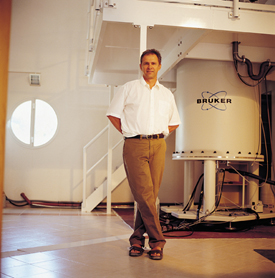Are you a journalist? Please sign up here for our press releases
Subscribe to our monthly newsletter:

The smaller an object, the larger the equipment needed to measure it. This rule of thumb comes to mind when looking up at the daunting nuclear magnetic resonance (NMR) machinery in Prof. Jacob Anglister's laboratory. A member of the Department of Structural Biology at the Weizmann Institute of Science, Anglister uses NMR to probe how molecules in the cell interact. 'Numerous biological processes, including protein production, cellular division, and immune response, depend on two molecules recognizing and responding to each other,' Anglister explains. 'NMR enables us to study this key recognition aspect at the atomic level. For instance, we can capture a three-dimensional representation of the complex formed when two proteins meet.'
Examples of the protein one-on-ones that have grabbed Anglister's attention include what happens when antibodies, the immune system's 'infantry' soldiers, recognize and attack invading proteins; how scorpion neurotoxins bind to neuronal membranes; and how interferon alerts the body to use its antiviral and anticancer weapons. His team is currently focusing on antibodies against the HIV (human immunodeficiency virus) that causes AIDS.
During the initial stage of infection, a protein on the envelope of the HIV virus known as gp120 binds to two different immune cells - T-cells and macrophages. This bonding triggers conformational changes in gp120 that mediate the fusion between the virus and its target cells.
Using NMR, Anglister has revealed the complex formed between the HIV virus and the body's immune cells, and honed in on a region in gp120, called the V3-loop. This loop plays a key role in binding the HIV virus to its target cells - indeed, the immune system generates antibodies whose sole function is to bind with the V3-loop, thus neutralizing the virus. The HIV virus, however, is able to overcome this defense strategy by rapidly mutating the V3-loop to escape detection. Another trick, used by what is perhaps the nastiest strain of this virus, is to hide the V3-loop until the very moment it is needed to bind the virus to its target, so that no immune antibodies will be produced.
A key puzzle to researchers is how the virus is able to use the V3-loop on its envelope to bind to target cells yet at the same time mutate this loop to escape detection. Having uncovered the detailed structure of the V3-loop, Anglister's team may now have a partial answer. In what appears to be an ingenious decoy approach, the DNA encoding the V3-loop consists of two primary types of sites - evolutionarily conserved sites (which suggests they are highly important for viral replication) and rapidly mutating sites that 'cover'/protect the conserved region from attack. Since the protein segments encoded for by the mutating regions are highly exposed on the virus envelope, they quickly draw the immune cells' fire. But because these regions mutate so quickly, the body is unable to mount an effective response. Furthermore, even when the immune cells succeed in generating antibodies against the conserved protein segments, the mutating regions obstruct their attack.
A peptide-based vaccine may offer a partial solution, as demonstrated by Institute Profs. Michael Sela and Ruth Arnon, who pioneered the application of synthetic vaccines. They showed that synthetic peptides could be used to generate a protective immune response against various pathogens. This approach may be especially beneficial in the case of HIV, as it can trigger an immune response against viral regions that, like the V3-loop, are generally hidden. A cocktail of peptides found in the protein sequences of major HIV strains may help researchers target this elusive virus.
Anglister's team is currently studying an antibody, isolated from an HIV patient by an American research group, which is capable of neutralizing various HIV viral strains that have undergone V3-loop mutations. 'Our aim is to use NMR to discover the secret of this antibody's success,' says Anglister. 'Such understanding may help in designing an optimal peptide-based HIV vaccine.'
NMR makes possible the study of protein molecules in solution. It can also provide information about dynamic processes in the body occurring at a rate of up to a millionth of a second.
Scientists had traditionally relied on X-ray crystallography to elucidate protein structures. However, when using crystallography one has first to create crystals of the protein in question - an often difficult process.
Additionally, crystallography cannot be performed on solutions, where biological molecules exhibit their activity. The first three-dimensional NMR structure of a protein was solved in 1985 by Kurt Wuthrich and his co-workers at the Swiss Federal Institute of Technology (ETH) in Zurich.
In using NMR to probe the structure of protein molecules, a small amount of a solution containing the protein is placed in a magnetic field and an electro-magnetic current is applied at varying frequencies, thus selectively activating the nuclei in the atoms making up the protein molecule.
Since each nucleus -- say that of a carbon or hydrogen atom -- responds with its own unique spin, scientists can use sensitive recording equipment to detect the resultant magnetic fields. They then use this information to construct a three-dimensional picture of the entire protein molecule.
The first NMR application was developed back in the 1940s by Felix Bloch of Stanford University and Harvard's Edward Purcell, earning them the 1952 Nobel Prize in Physics. Weizmann Institute scientists Shlomo Alexander and Shaul Meiboom built the world's second high-resolution NMR spectrometer in the 1950s. The system was used to pioneer the research of chemical reactions in equilibrium, and to explore the structure and behavior of molecules. Later Meiboom, Alexander, and other Institute scientists, using nuclear quadropolic resonance, developed a method of measuring the movement of molecules in crystals.
Prof. Anglister holds the Joseph and Ruth Owades Professorial Chair in Chemistry. His research is supported by the Burstein Family Foundation, the Minerva Stiftung Gesellschaft fuer die Forschung m.b.H., the Nelfort Foundation and Mr. and Mrs. Samy Cohn.